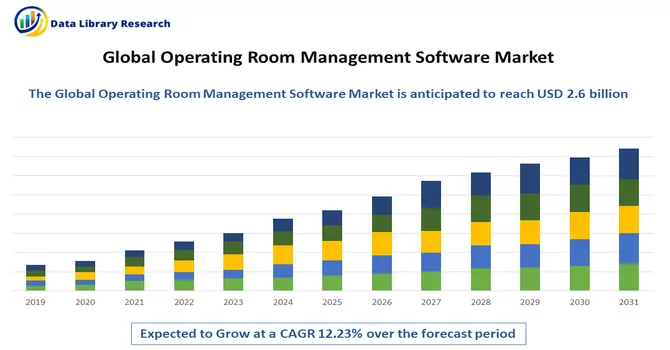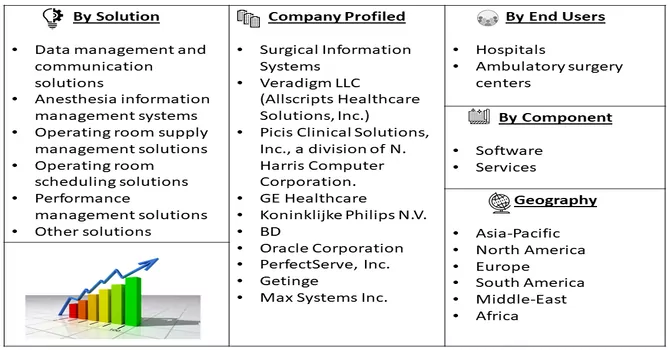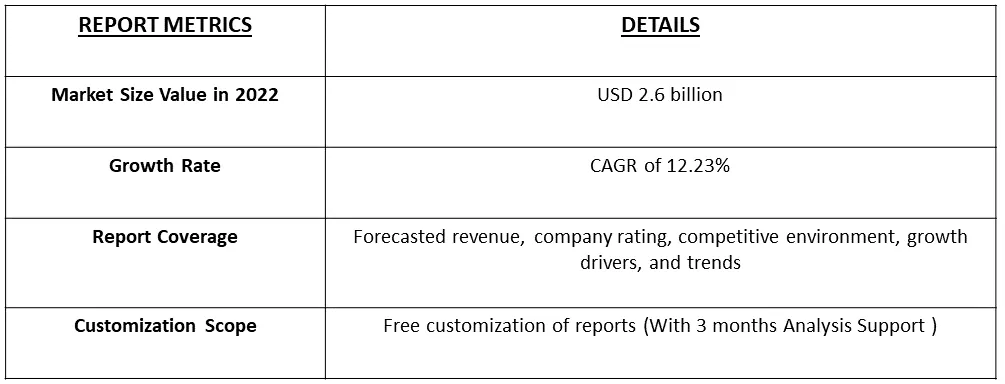The global market size for operating room management software reached an estimated value of USD 2.6 billion in 2022, and it is anticipated to experience a steady growth trajectory with a compound annual growth rate (CAGR) of 12.23% from 2023 to 2030.

Get Complete Analysis Of The Report - Download Free Sample PDF
Operating Room Management Software refers to specialized software applications designed to streamline and optimize the various processes and tasks associated with the management of operating rooms (ORs) within healthcare facilities. These software solutions are tailored to meet the unique needs of surgical environments, aiming to enhance efficiency, coordination, and overall performance.
This expansion is primarily driven by various factors, such as the widespread adoption of electronic health records (EHRs), a surge in the number of surgical procedures, an increased emphasis on cost reduction and operational efficiency in both hospitals and ambulatory Surgery Centers (ASCs), and continuous technological advancements in the field of operating room management. As the healthcare sector progressively undergoes digital transformation, the significance of these software solutions is on the rise. They play a pivotal role in optimizing critical aspects of surgical operations, including scheduling, resource allocation, and the management of patient data. By doing so, these software solutions contribute to heightened efficiency levels and an improved quality of patient care. The integration of such advanced technologies has become essential for healthcare facilities seeking to enhance overall operational performance and keep pace with the evolving landscape of modern healthcare.
Market Segmentation: Operating Room Management Market by Solution (Data management and communication solutions, Anesthesia information management systems, Operating room supply management solutions, Operating room scheduling solutions, Performance management solutions, Other solutions), by Component (Software, and Services), by End User (Hospitals, Ambulatory surgery centers) and Geography (North America, Europe, Asia-Pacific, Middle-East and Africa, and South America). The market provides the value (in USD million) for the above-mentioned segments.

For Detailed Market Segmentation - Download Free Sample PDF
The increasing trend towards digital transformation in the healthcare sector is propelling the adoption of Operating Room Management Software. Healthcare facilities are leveraging these solutions to automate processes, enhance efficiency, and improve overall patient care. A growing emphasis on integrated healthcare systems has led to the integration of Operating Room Management Software with Electronic Health Records. This trend facilitates seamless data exchange, providing a comprehensive view of patient information and ensuring continuity of care throughout the surgical process.
Market Driver:
Rising Surgical Procedure Volumes and Growing Digital Transformation in Healthcare
The global increase in the number of surgical procedures is a key driver for the operating room management software market. As the demand for surgical services grows, healthcare facilities seek advanced solutions to optimize scheduling, resource allocation, and overall operational efficiency in operating rooms. The ongoing digital transformation in the healthcare sector is a significant driver for the adoption of operating room management software. Healthcare facilities are increasingly recognizing the value of digital solutions to enhance efficiency, reduce errors, and improve overall patient care in the surgical setting. Thus, owing to such reasons the market is expected to witness significant growth over the forecast period.
Advancements in Technology and Integration with Electronic Health Records (EHRs)
The continuous advancements in technology, including artificial intelligence (AI) and machine learning, contribute to the evolution of operating room management software. These technologies enable intelligent scheduling, predictive analytics, and improved decision-making, enhancing the overall functionality and effectiveness of the software. Furthermore, the integration of operating room management software with electronic health records is becoming increasingly important. Seamless data exchange between these systems ensures a comprehensive view of patient information, promoting continuity of care and reducing the risk of errors. Thus, owing to such advantages, the market is expected to witness significant growth over the forecast period.
Market Restraints
Resistance to Technological Adoption and Data Security and Privacy Concerns
Some healthcare institutions may exhibit resistance to the adoption of new technologies, including operating room management software. This resistance can stem from concerns about staff training, workflow disruptions, and the perceived complexities associated with transitioning to digital solutions. Also, with the increasing reliance on digital systems, data security and privacy concerns pose a restraint to the adoption of operating room management software. Healthcare organizations must navigate stringent regulations and safeguard patient information, leading to careful consideration and potential hesitation in implementing new software solutions. Thus, these marker factors are expected to slow the growth of the studied market over the forecast period.
The operating room management market share experienced a negative impact from the COVID-19 pandemic, mirroring the challenges faced by several healthcare information technology sectors. The pandemic led to workforce disruptions, staffing challenges, the reordering of procedural priorities, increased transmission risks during surgical procedures, and setbacks in surgical education. Consequently, there was a notable decline in the number of surgeries conducted in hospitals. The implementation of technologies within healthcare facilities was hindered due to lockdown measures, resulting in financial revenue losses for numerous market players. As an illustration, TietoEVRY, based in Finland, reported an overall decrease in revenues in 2020 compared to 2019, attributing this decline to the repercussions of the COVID-19 pandemic. Additionally, a study conducted by Springer Nature investigated the pandemic's impact on the admission rates and in-hospital mortality of cases, as well as the prevalence of COVID-19 among general surgery patients in 66 general hospitals across Germany in 2020. The analysis revealed a significant decrease of 22.7% in the total number of patients in general and visceral surgery. A significant disruption in the demand and supply dynamics of operating room management systems stemmed from a shortage of suppliers, as numerous industries ceased operations due to lockdown mandates. The supply chain for operating room management systems was further impeded by global transport restrictions implemented to mitigate the spread of the pandemic.
Segmental Analysis:
Data management and communication solutions Segment is Expected to Witness Significant Growth Over the Forecast Period
Data management and communication solutions play a crucial role in today's digital landscape, offering organizations the tools to efficiently handle, organize, and transmit information. These solutions are fundamental across various industries, ensuring the secure and streamlined flow of data for enhanced decision-making and operational efficiency. Data security solutions encompass measures to protect data from unauthorized access, disclosure, alteration, or destruction. Cloud-based data management involves storing and managing data on remote servers accessed via the internet. Thus, the segment is expected to witness significant growth over the forecast period.
Software Segment is Expected to Witness Significant Growth Over the Forecast Period
Software, in a broad sense, refers to a set of instructions that enable a computer or electronic device to perform specific tasks or functions. Operating Room Management Software is a specialized type of software designed to optimize and streamline the various processes and workflows within an operating room (OR) or surgical suite. Operating Room Management Software contributes to increased efficiency, reduced errors, improved patient outcomes, and better utilization of resources in surgical settings. Software is the driving force behind the functionality of computers and electronic devices. It enables users to perform tasks, run applications, and interact with hardware components. Thus, the segment is expected to witness significant growth over the forecast period.
Hospitals Segment is Expected to Witness Significant Growth Over the Forecast Period
Hospitals globally are increasingly turning to sophisticated solutions like Operating Room Management Software to address the unique challenges and complexities of managing surgical suites. This specialized software is designed to optimize and streamline the various processes within operating rooms (ORs) to enhance efficiency, resource utilization, and overall patient care. Operating Room Management Software facilitates the organized management of patient information, including medical records and surgical plans, contributing to personalized and well-informed care. Effective management of surgical supplies through inventory management features helps hospitals optimize stock levels, minimize waste, and ensure the availability of necessary supplies during surgical procedures. Thus, the segment is expected to witness significant growth over the forecast period.
North America Region is Expected to Witness Significant Growth Over the Forecast Period
North America is a significant market for Operating Room Management Software (ORMS), with the region witnessing a growing adoption of advanced healthcare technologies to enhance efficiency, improve patient care, and address the challenges within surgical environments. Prominent hospitals and healthcare facilities across North America are increasingly integrating Operating Room Management Software into their operations. These facilities recognize the value of ORMS in optimizing surgical workflows, resource allocation, and overall operational efficiency. The seamless integration of Operating Room Management Software with Electronic Health Records is a priority in North America. This integration ensures a comprehensive view of patient information, supporting continuity of care and reducing the risk of errors. Thus, region is is expected to witness significant growth over the forecast period.

Get Complete Analysis Of The Report - Download Free Sample PDF
The market is competitive owing to the presence of key providers. Companies are adopting various strategies, such as partnerships, new product launches, and regional expansions, to gain higher market shares
Key Operating Room Management Software Companies:
Recent Developments:
1) In September 2023, Fujitsu and Baptist Health South Florida unveiled a groundbreaking solution designed to revolutionize operating room scheduling. The core goals of this innovative solution are to enhance utilization rates and enhance the financial viability of the surgical discipline.
2) In May 2023: Royal Philips reported the debut of Philips Virtual Care Management, a comprehensive portfolio of flexible solutions and services to help health systems, providers, payers and employer groups more meaningfully motivate and deeply connect with patients from virtually anywhere. Philips Virtual Care Management can help reduce pressure on hospital staff by decreasing emergency department visits, as well as reducing the cost of care through better management of chronic disease.
Q1. What was the Operating Room Management Software Market size in 2022?
As per Data Library Research the global market size for operating room management software reached an estimated value of USD 2.6 billion in 2022.
Q2. What is the Growth Rate of the Operating Room Management Software Market?
Operating Room Management Software Market is expected to grow at a compound annual growth rate (CAGR) of 12.23% over the forecast period.
Q3. What are the factors on which the Operating Room Management Software Market research is based on?
By Solution, By Component, End-User and Geogrpahy are the factors on which the mango market research is based.
Q4. Which region has the largest share of the Operating Room Management Software Market? What are the largest region's market size and growth rate?
North America has the largest share of the market . For detailed insights on the largest region's market size and growth rate request a sample here
Data Library Research are conducted by industry experts who offer insight on industry structure, market segmentations technology assessment and competitive landscape (CL), and penetration, as well as on emerging trends. Their analysis is based on primary interviews (~ 80%) and secondary research (~ 20%) as well as years of professional expertise in their respective industries. Adding to this, by analysing historical trends and current market positions, our analysts predict where the market will be headed for the next five years. Furthermore, the varying trends of segment & categories geographically presented are also studied and the estimated based on the primary & secondary research.
In this particular report from the supply side Data Library Research has conducted primary surveys (interviews) with the key level executives (VP, CEO’s, Marketing Director, Business Development Manager and SOFT) of the companies that active & prominent as well as the midsized organization
FIGURE 1: DLR RESEARH PROCESS

Extensive primary research was conducted to gain a deeper insight of the market and industry performance. The analysis is based on both primary and secondary research as well as years of professional expertise in the respective industries.
In addition to analysing current and historical trends, our analysts predict where the market is headed over the next five years.
It varies by segment for these categories geographically presented in the list of market tables. Speaking about this particular report we have conducted primary surveys (interviews) with the key level executives (VP, CEO’s, Marketing Director, Business Development Manager and many more) of the major players active in the market.
Secondary ResearchSecondary research was mainly used to collect and identify information useful for the extensive, technical, market-oriented, and Friend’s study of the Global Extra Neutral Alcohol. It was also used to obtain key information about major players, market classification and segmentation according to the industry trends, geographical markets, and developments related to the market and technology perspectives. For this study, analysts have gathered information from various credible sources, such as annual reports, sec filings, journals, white papers, SOFT presentations, and company web sites.
Market Size EstimationBoth, top-down and bottom-up approaches were used to estimate and validate the size of the Global market and to estimate the size of various other dependent submarkets in the overall Extra Neutral Alcohol. The key players in the market were identified through secondary research and their market contributions in the respective geographies were determined through primary and secondary research.
Forecast Model
